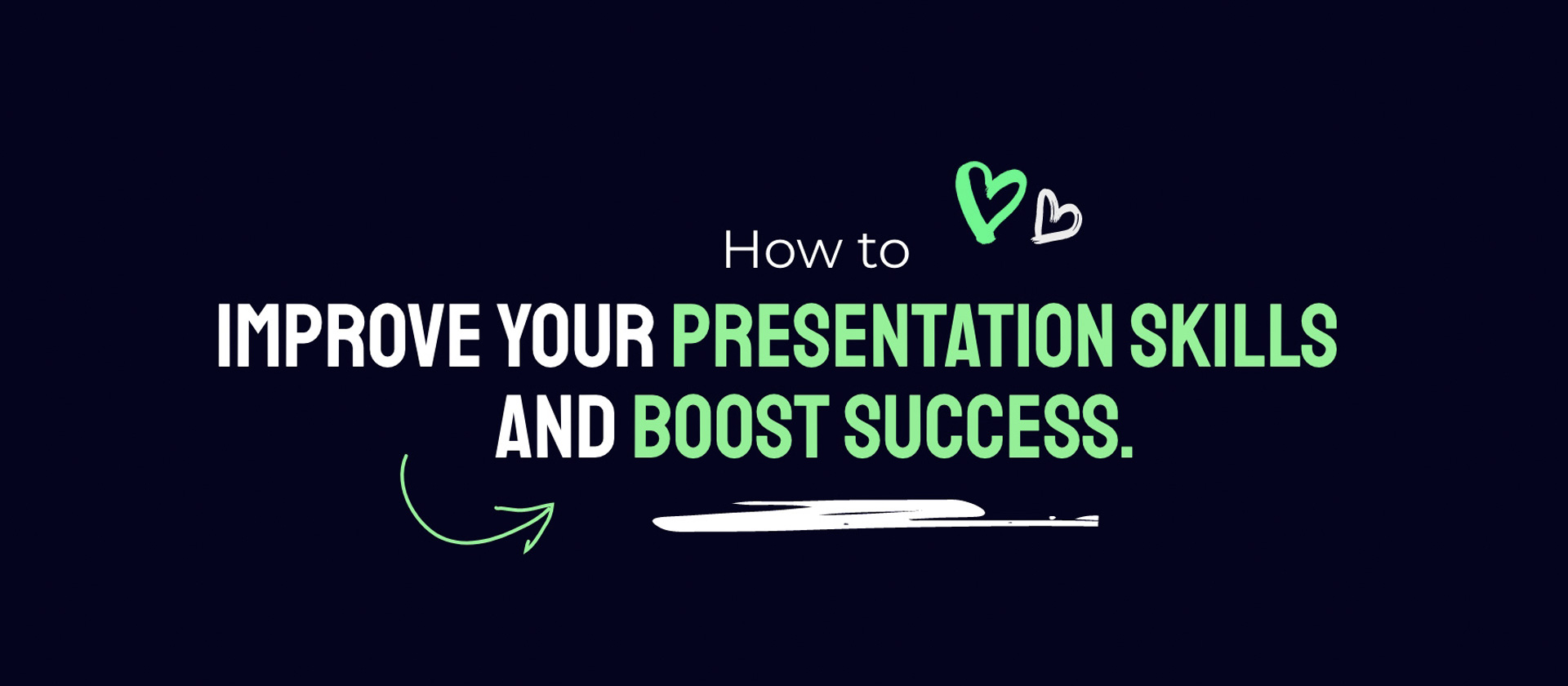Find out how to improve your team’s presentation skills to make the most of every opportunity that presents itself. Learn to increase your success at every pitch, or even every conversation, and have fun doing it.
Fail to prepare, prepare to fail
By chatting to a whole bunch of lovely people like you, we found out that 77% of people are expected to deliver presentations as part of their day-to-day jobs. But only 23% of these people have been trained in how to improve their presentation skills and increase their success. And the impact of this lack of training is clear. Businesses are losing business. In fact, 26% of businesses have lost a potential customer because they delivered a poor presentation. And 25% lost an existing customer for the same reason.
If the thought of dedicating a chunk of everyone’s time to learning the ins and outs of PowerPoint made you shudder, you’re not alone. For too long, we’ve been subjected to Death by PowerPoint. Made to sit through presentations written by the presenter’s ego. Tortured by decks thrown together in a way that makes our eyeballs sore. It’s no wonder you aren’t that fond of PowerPoint. But, if we could just have your attention for one moment, we’re about to reveal two shocking truths.
- PowerPoint presentations can be compelling, inspiring, and engaging.
- Your people can learn how to make them this way in a way that’s actually fun for them.
Gasp.
What are presentation skills?
By learning how to improve your presentation skills, you and your team can start to connect all that knowledge inside your beautiful heads with the selfish motivations and frustrations of your audience. Show them that you are – essentially – their fairy godmother. You’re just here to take their troubles away and help them reach their goals.
But, to do this, you need to know what you’re doing in four key areas:
- Storytelling
- Design
- Build
- Delivery
By focusing a little time on learning how to improve your presentations skills, you can transform your whole team into polished, professional, and persuasive communicators under any conditions. And we’re here to help you. And we’ll do that with some fun games you can enjoy while learning how to improve your presentation skills.
Pillar one: storytelling
55% of people say a great story is what holds their attention during a presentation. But 46% of presenters find that crafting a compelling story is the hardest part of the presentation journey. There is a skills gap here that needs to be addressed, if you’re going to increase your success.
Audiences connect with stories because they help them to see themselves as the hero. And who’s not looking for that ego boost whenever they walk into a social setting? By speaking to their selfish motives, your stories can draw a clear line from the audience’s challenges to your product or service as the solution. Basically, stories do the hard work for you.
And once you’ve massaged their ego, you kinda need your audience to remember what you’ve told them. When they’re making their decision later on, you need to have firmly established yourself as the only reasonable choice. Stories help here too.
Messages delivered as stories can be up to 22 times more memorable than facts alone. Stories act as mnemonic devices, organising your key messages into meaningful structure. This structure makes them easier to recall. If you teach your team to wrap your stats and product benefits up as a story, it will mean your presentations stay with your audience long after you’ve left the room.
Storytelling game to improve your presentation skills

Do you know that memory game where you’re given a list of random words and you have to try to recall as many as possible? This is the same game, with a storytelling spin.
Split your team into pairs. Give one person in each pair a piece of paper with around fifty random words on. Of those fifty, ten should be highlighted. The person with the list needs to make up a story that includes every highlighted word – and none of the others. And they need to tell that story to their teammate.
Once all the stories have been constructed and recalled, the other person in the pair gets that same list of fifty words, but without any highlights. They get two minutes to highlight the words they can recall from their teammate’s story.
You could then repeat the game, with roles reversed. This would make sure everyone gets a chance to work on their storytelling. And they’d get to see, first hand, the impact stories have on our memory.

Storytelling training
to make your whole team dangerously persuasive.
Pillar two: design
Did you know that 91% of presenters feel more confident presenting with a well-designed slide deck? Now, just imagine the confidence that would come from knowing that that well-designed slide deck was built with your own hands. Some simple design tips can increase the confidence, autonomy, and pride of everyone tasked with building presentations in your team.
And the benefits would reach much further than your immediate team.
Inconsistent branding can damage the trust between you and your audience. If your brand voice, identity, and visuals change every time they come into contact with you, they’ll be all kinds of confused at what you do and, more importantly, why. But checking every slide your team makes before they put them in front of your audience is time consuming. You have better things to be doing.
One way to enable your team to create their own consistent visual stories is by providing them with an easy-to-use template. This template can be designed to reflect your brand identity. And it should have strong visual foundations in place, for your people to simply add their content too.
But a template isn’t a fool-proof solution. Not that your team members are fools, of course.
If you want to be able to rest easy, knowing your brand is being correctly and consistently represented, you need to train everyone who uses your template to use it with careful and responsible consideration.
The template alone can be an excellent guide. And it stops them having to start from scratch. But all too often we still see people cramming their template layouts full to the brim with content and copy. And often they ignore the placeholders altogether. This game is a fun way to make sure people know how to edit paragraphs down to just the key messages.
Design game to improve your presentation skills

We’ve all played a game or two of Snog, Marry, Avoid in our time, right?
If not, here’s the premise: you’re given the names of three people – usually celebrities – and you have to choose who to snog, who to marry, and who to avoid. It’s a laugh riot.
This is the presentation design version.
Give your team a paragraph of text. It can be the same for everyone, or different. As long as each paragraph is about the same length and has about as many important messages in amongst the filler.
Snog: get them to transfer all the information they think is relevant to their audience from the paragraph into their speaker notes.
Marry: ask them to extract the most important, hard-hitting points to add back onto the slide.
Avoid: tell them to edit, edit, edit. They need to ditch any excess sentences or words. Say buh-bye to anything the audience already knows. Get rid of anything they really don’t care to know. And keep going until they each have an impactful, relevant, and persuasive slide in front of them.
Pillar three: build
Most people spend 50+ hours a month building presentations, with each presentation averaging out at eight hours’ build time. That’s a whole working day spent simply creating the slides for a presentation. But PowerPoint wants to help you. It has all the tools you need to build impactful slides quickly and easily. You just need to know where to find them.
Training your people to use all the most effective and efficient tools in this extensive software could recover a big chunk of lost time for everyone tasked with creating presentations in your company. And make them much happier with the task at hand.
Build game to improve your presentation skills

To instil all the wonders of the Quick Access Toolbar in your team, let’s pit them against one another in a game of quick build.
Split your team into two. Give one half – secretly and in advance – instructions to set up their Quick Access Toolbar. Ask them to add the PowerPoint functions that are going to speed up their build. If you’re not sure which to choose, our favourites are Align, Distribute, Send to back, and Bring to front.
Put a beautiful, pre-designed slide up on a screen that everyone can see. Set a cruelly-short timer and ask them to build their best interpretation. Once the timer has gone off, deduct points for unevenly-spaced elements, objects out of alignment, inconsistencies, and all the other issues that PowerPoint can do for them automatically, if only they knew which tool to use.

Become presentation pros with our
PowerPoint template training.
Pillar four: delivery
This is the scary part: actually presenting. Fear of public speaking is one of the most common everyday worries in the UK, affecting around 77% of Brits. But great presenters are made, not born. Anyone has what it takes to be a confident and compelling speaker. They might just need a little support in developing these skills.
And even if you feel like an accomplished presenter, chances are the pandemic threw a few spanners in your works. It forced us all to scramble to adapt to virtual presenting and a whole new set of challenges. And this way of operating doesn’t look set to go away anytime soon. If your team can present just as well virtually as they can face to face, you can meet the audience’s need and show you’re both capable and flexible, right from the start of your relationship.
Here’s an enjoyable game you can play both in person and virtually. It will help your team to improve their presentation delivery by reducing distracting tell-tale signs of nerves.
Delivery game to improve your presentation skills

In advance, prepare enough unique bingo cards with common presenting habits on for each player to have one. Here are some ideas to get you started:
- Saying ‘Ummm’ or other filler words
- Reading from slide
- Playing with hair
- Standing completely still
- Moving too much
- Shifting weight
- Outrageously big hand gestures
- Constant hand movement
- Pulling at clothes
- Biting lip
- No eye contact
- Erratic eye contact
- Long pauses
- Sheer panic
- Speaking too fast
- Speaking too slow
You get the idea.
Pick one person to present. All the others need to be on the lookout for these distracting habits. When they spot one that matches one on their card, they cross it off with a pencil. As soon as someone has a full line, the presenter is out, and the winner steps up to take their place. The audience erase the marks on their bingo card and can swap them around if they want. And the game continues. Once everyone’s presented, whoever spent the longest in the spotlight is the winner.
You’ll need to moderate by jotting down all the distracting habits you see, to check there’s no cheating. And you need to keep track of each person’s time spent presenting.
It may seem cruel, but a lot of the time, people aren’t even aware that their nervous habits are distracting to the audience. This will give them some clear goals, so they can work to remove them next time they practice.

Emerge as thought leaders with our
virtual presentation skills training.
How to further improve your presentation skills
That was super fun, wasn’t it?
Can you imagine how much fun you and your team could have if you were to attend one of our training sessions? And how much more you’d learn with two of our presentation experts on hand to deliver a completely hands-on session that’s tailored to your needs and skill levels? It boggles the mind.
We can deliver sessions that are focused on just one area of presentations skills, or a high-level look at every aspect.
Our persuasive storytelling training will train your team to tell your company story in a way the individual in front of them will actually care about. They’ll learn how to step into their audience’s shoes, tell tales that change behaviours, and write stories that will blow their audiences’ minds.
Our hands-on PowerPoint template training has been designed to teach your team how to make their own next-level presentations, quickly and easily, making the most use of your shiny new Buffalo 7-built template.
And our virtual presentation training covers everything from adapting your content to meet your new environment and the best technology for an essential home set up, to differences in delivery that every successful virtual presenter needs to take into account.
No matter the level you’re currently at when it comes to presentation creation and delivery, or the level you wish to be at, we can teach you how to improve your presentation skills to amplify the success of your entire team, every time they present.



